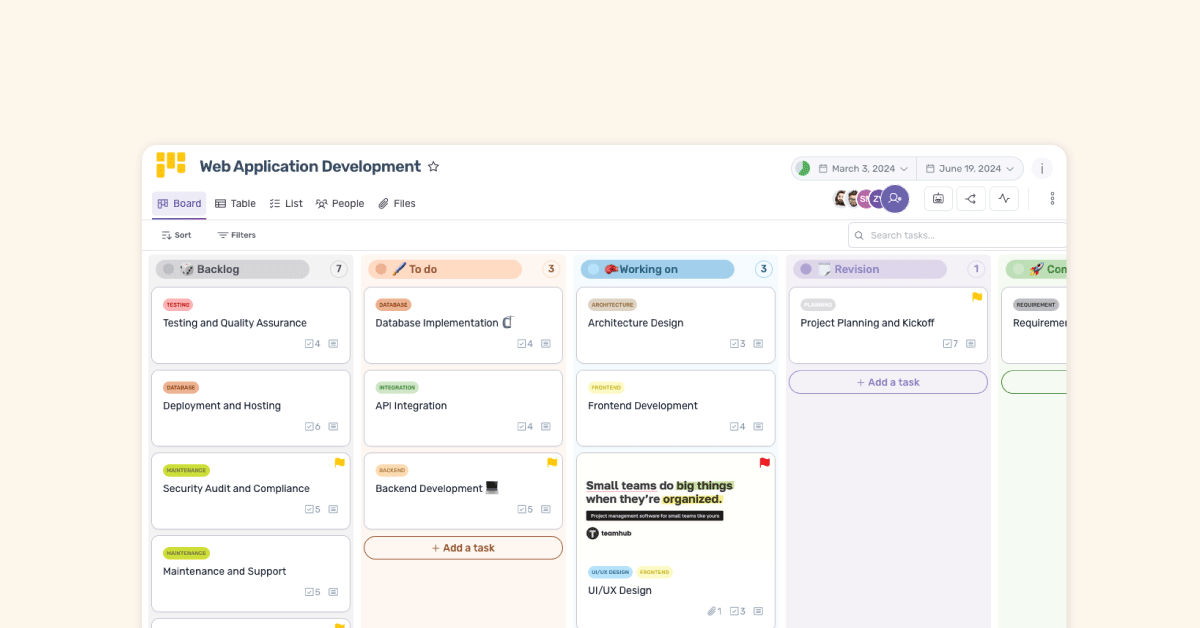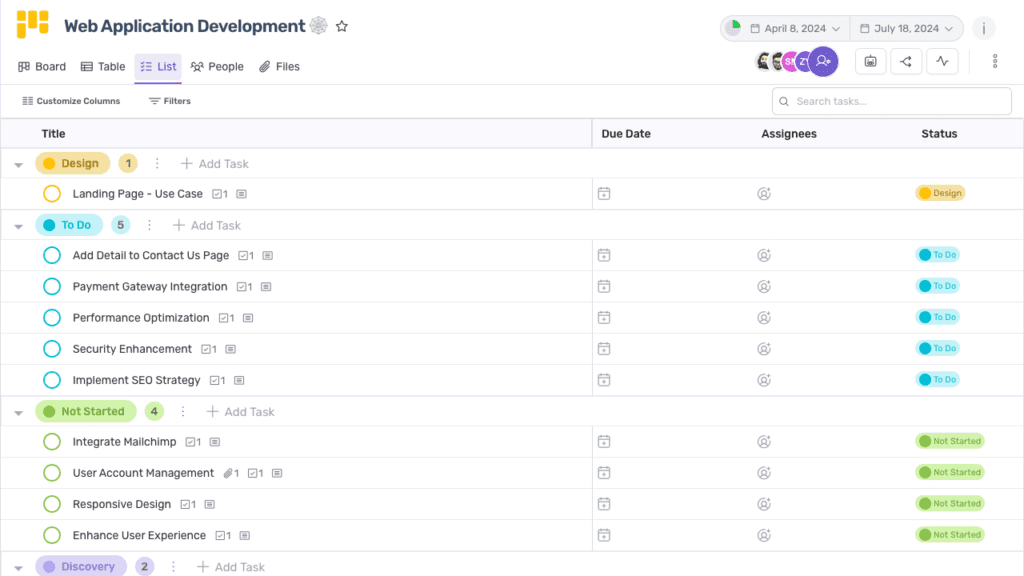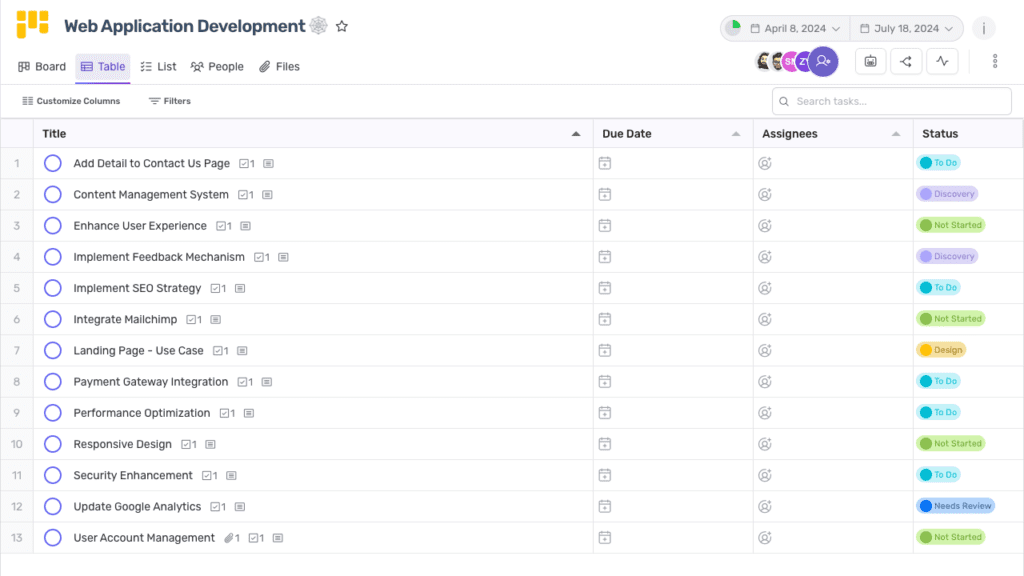LIMITED TIME OFFER
Replace all of these

with a single tool for just $1 per month for your entire team
UNLIMITED USERS
UNLIMITED PROJECTS
UNLIMITED CHATS
UNLIMITED DOCS
UNLIMITED STORAGE
AND MORE..
Web Application Development Project Template

Web application development has become an integral part of the business world. From e-commerce platforms to online banking systems, companies rely on web applications to interact with their customers and streamline their operations. However, developing a successful web application requires careful planning and attention to detail. That’s where a comprehensive web application development project template comes into play.

Understanding Web Application Development
Before delving into the importance of a project template, it’s essential to grasp the basics of web application development. At its core, web application development involves creating dynamic websites that can perform various tasks and interact with databases. This process requires a combination of programming languages, such as HTML, CSS, and JavaScript, along with server-side technologies like PHP or Java.
Web application development is a multifaceted discipline that encompasses a wide range of skills and technologies. Developers must not only be proficient in coding but also understand user experience design principles and database management. By combining these different areas of expertise, developers can create robust and user-friendly web applications that meet the needs of both clients and end-users.
The Basics of Web Application Development
When starting a web application development project, it’s crucial to have a solid understanding of the foundational concepts. This includes familiarizing oneself with HTML tags, CSS stylesheets, and JavaScript functions. A strong grasp of these essentials will pave the way for efficient development and ensure a seamless user experience.
Furthermore, developers should also be well-versed in responsive web design principles to ensure that their applications are accessible and functional across various devices and screen sizes. This involves creating flexible layouts, using media queries, and optimizing images for faster loading times. By prioritizing responsive design, developers can enhance the usability and accessibility of their web applications.
Key Components of Web Application Development

In addition to the basics, web application development has several key components that must be considered. These components include database management, server-side scripting, and front-end design. Each element plays a crucial role in building a successful web application, and neglecting any one of them could result in a subpar user experience or even project failure.
Effective database management is essential for storing and retrieving data efficiently, while server-side scripting languages like Python or Ruby on Rails enable dynamic content generation and interaction with databases. On the other hand, front-end design focuses on creating visually appealing and intuitive user interfaces that enhance the overall user experience. By integrating these components seamlessly, developers can create powerful and engaging web applications that meet the needs of modern users.
Importance of a Project Template in Web Application Development
Now that we have a foundation in web application development, let’s explore why a comprehensive project template is essential for this process.
When delving into the realm of web application development, it becomes apparent that having a well-structured project template is akin to having a blueprint for a grand architectural masterpiece. Just as a blueprint guides architects in constructing a building with precision and efficiency, a project template serves as a roadmap for developers, leading them through the intricate process of creating a functional and visually appealing web application.
Streamlining the Development Process
Developing a web application from scratch can be a time-consuming and complex endeavor. However, with a project template in place, developers can streamline their workflow and avoid reinventing the wheel for each project. By having predefined guidelines, standards, and processes, the development team can focus on building the application’s unique features.
Moreover, a project template acts as a repository of knowledge and expertise accumulated over time, encapsulating the collective wisdom of seasoned developers. It empowers new team members to quickly grasp the project’s intricacies and align themselves with the established development practices, thus fostering collaboration and knowledge sharing within the team.
Ensuring Consistency and Quality
Consistency and quality are vital factors in web application development. A project template helps ensure that all projects adhere to a set of predefined guidelines, which results in a consistent user experience across all applications. Additionally, by following established coding standards and best practices, web applications will have a solid foundation that promotes scalability, maintainability, and long-term success.
Furthermore, a project template serves as a guardian of quality assurance, acting as a gatekeeper that upholds the standards of excellence in every line of code written. It instills a culture of meticulousness and attention to detail within the development team, fostering a mindset where quality is not just a goal but a non-negotiable principle embedded in every phase of the development lifecycle.
Elements of a Comprehensive Web Application Development Project Template
Now that we understand the importance of a project template, let’s delve into the essential elements that make up a comprehensive template.
When it comes to web application development, a well-defined project scope and objectives are crucial. This involves more than just outlining the desired features and functionalities. It requires a deep understanding of the target audience and their specific needs. By conducting thorough research and analysis, developers can gain valuable insights into user preferences and pain points. Armed with this knowledge, they can then establish clear goals and objectives that the application aims to achieve. Whether it’s increasing user engagement, streamlining business processes, or enhancing customer satisfaction, defining the project scope and objectives is the foundation upon which successful web applications are built.
Design and User Interface Guidelines
The design and user interface (UI) of a web application play a significant role in user satisfaction. Within the project template, design and UI guidelines outline the visual elements, color schemes, typography, and overall aesthetic of the application. These guidelines ensure a consistent and intuitive user experience, making it easier for users to navigate and interact with the application.
But it’s not just about aesthetics. Design and UI guidelines also take into consideration usability principles and accessibility standards. They address factors such as responsive design, ensuring that the application looks and functions seamlessly across different devices and screen sizes. By incorporating these guidelines into the project template, developers can create web applications that not only look visually appealing but also provide a user-friendly experience for all users, regardless of their abilities or devices.
Development and Coding Standards
Establishing development and coding standards is vital for writing clean and maintainable code. The project template should include guidelines for naming conventions, code structure, documentation, and version control. By adhering to these standards, developers can collaborate more effectively and maintain code integrity throughout the project’s lifecycle.
Consistent coding standards not only improve code readability but also facilitate code reuse and scalability. They ensure that developers can easily understand and work with each other’s code, reducing the chances of errors and conflicts. Additionally, well-documented code and version control practices enable efficient troubleshooting and future enhancements. By incorporating these development and coding standards into the project template, developers can streamline their workflow and produce high-quality code that is both robust and maintainable.
Testing and Quality Assurance Procedures
To ensure a high-quality web application, testing and quality assurance procedures should be an integral part of the project template. This includes defining testing methodologies, creating test plans, and establishing quality checkpoints throughout the development process.
Thorough testing is essential to identify and fix any bugs or issues before the application is deployed to the users. It involves various types of testing, such as unit testing, integration testing, and user acceptance testing, to ensure that the application functions as intended and meets the defined requirements. Quality assurance procedures, on the other hand, focus on overall application quality, including performance, security, and compliance with industry standards.
By incorporating these procedures into the template, developers can identify and address issues early on, resulting in a more robust and reliable application. It also helps in building user trust and confidence in the application, as they can rely on its stability and functionality. Testing and quality assurance procedures are not just a one-time activity; they should be an ongoing part of the development process, ensuring continuous improvement and refinement of the web application.
Implementing the Project Template in Your Web Application Development
With a comprehensive project template in hand, the next step is to implement it effectively in your web application development process. The project template serves as a roadmap for your development team, outlining the structure, components, and best practices to follow throughout the project lifecycle. By adhering to the template, developers can streamline the development process, improve consistency across projects, and ensure alignment with industry standards.
Furthermore, the project template can enhance collaboration among team members by providing a common framework and reference point for discussions. It helps new team members onboard quickly by offering a structured approach to project development. Additionally, the template can serve as a knowledge-sharing tool, allowing developers to leverage past experiences and solutions for current projects.
Adapting the Template to Your Specific Needs
While a project template provides a solid foundation, it’s essential to adapt it to your specific needs. Every web application development project is unique, and the template should be flexible enough to accommodate different requirements. By customizing the template, developers can tailor it to match the project’s objectives, target audience, and technical constraints. This customization may involve adding or removing sections, updating technologies and tools, or adjusting processes to better align with project goals.
Moreover, adapting the template to specific needs can help optimize development efficiency and ensure that the final product meets the project’s success criteria. It allows developers to focus on key project deliverables, prioritize tasks effectively, and address any unique challenges or constraints early in the development process.
Managing Changes and Updates to the Template
As technology evolves and project requirements change, it’s crucial to keep the project template up to date. This involves revisiting the template periodically and making necessary updates based on lessons learned and emerging best practices. Regularly maintaining the template ensures that it remains a valuable resource for future web application development projects. By incorporating feedback from previous projects and industry advancements, the template can evolve to reflect the latest trends, tools, and techniques in web development.
Furthermore, managing changes and updates to the template fosters a culture of continuous improvement within the development team. It encourages developers to stay current with industry standards, experiment with new technologies, and refine development processes. This proactive approach to template maintenance can lead to enhanced project outcomes, increased efficiency, and a more robust foundation for future projects.
Measuring the Success of Your Web Application Development Project
Once your web application development project is complete, it’s important to measure its success and identify areas for improvement.
Measuring the success of a web application development project goes beyond just the completion of the project itself. It involves a comprehensive evaluation of various factors that contribute to its effectiveness and impact on users. From user experience to technical performance, every aspect plays a crucial role in determining the overall success of the project.
Key Performance Indicators for Web Application Development
Key performance indicators (KPIs) provide valuable insights into the success of a web application. These metrics can include user engagement, conversion rates, load times, and error rates. By monitoring and analyzing these KPIs, developers can make data-driven decisions and continually enhance the application’s performance and user experience.
Furthermore, KPIs serve as benchmarks for evaluating the effectiveness of different development strategies and techniques. They help in identifying areas that require attention and improvement, enabling developers to prioritize their efforts effectively and focus on aspects that have the most significant impact on the application’s success.
Continuous Improvement in Web Application Development
Web application development is an iterative process, and continuous improvement is crucial for staying ahead in a competitive market. Embracing a culture of continuous improvement within your development team encourages ongoing learning, experimentation, and innovation. A well-maintained project template serves as a foundation for this continuous improvement, guiding future projects towards even greater success.
Continuous improvement is not just about fixing bugs or adding new features; it’s about constantly seeking ways to optimize performance, enhance user experience, and adapt to evolving technologies and user preferences. By fostering a mindset of continuous improvement, development teams can ensure that their web applications remain relevant, efficient, and competitive in the ever-changing digital landscape.
Conclusion
A comprehensive web application development project template is a valuable asset for any development team. By understanding the basics of web application development, recognizing the importance of a project template, and implementing it effectively, organizations can streamline their development process, ensure consistency and quality, and measure the success of their projects. With continuous improvement as a driving force, web application development can deliver exceptional user experiences that meet the evolving needs of both businesses and consumers.
Ready to take your web application development to the next level? Teamhub is here to enhance your team’s collaboration and streamline your project management. With our intuitive platform, you can connect your departments and centralize your work in one hub for Projects and Documentation. Embrace the future of productivity and join the thousands of companies thriving with Teamhub. Start your free trial today and experience the power of a unified team!


